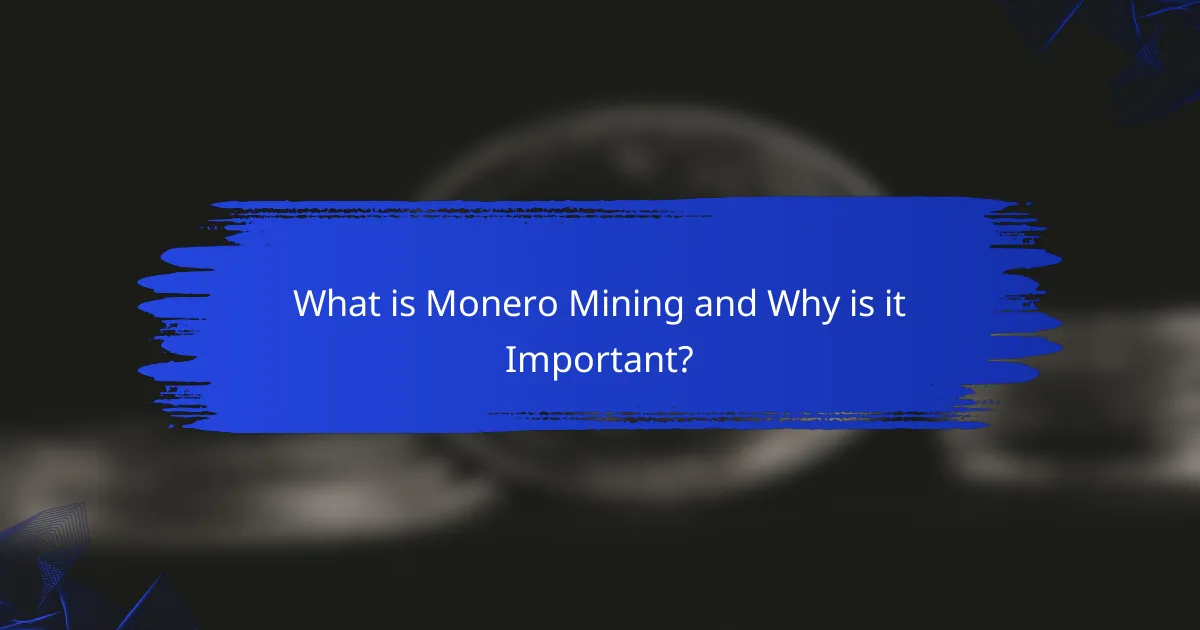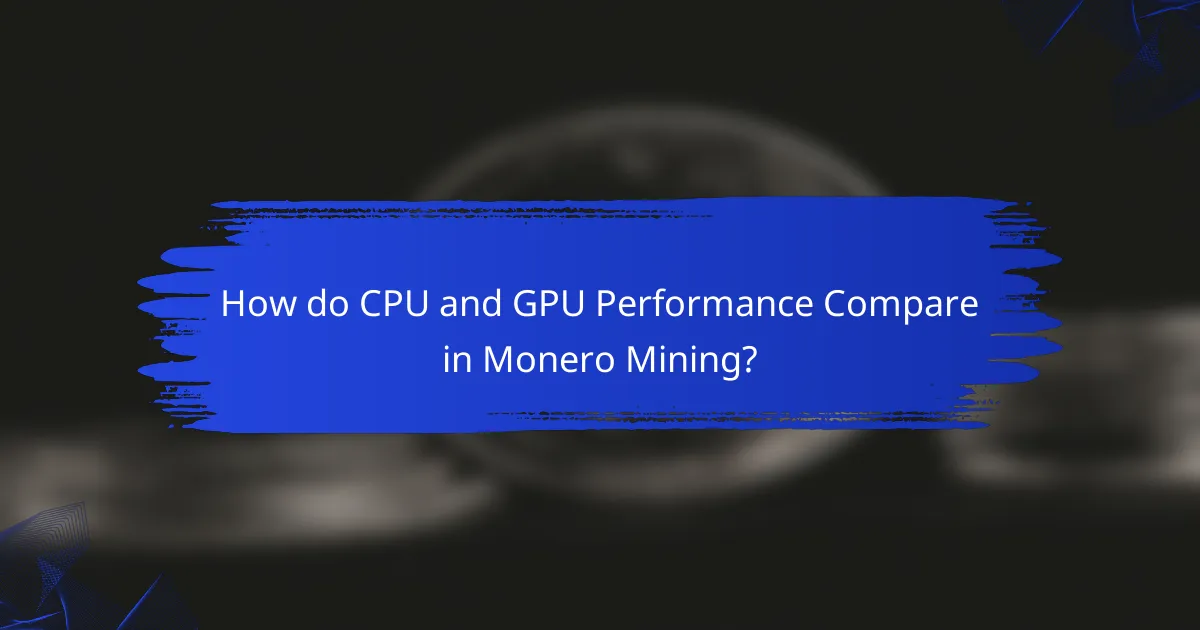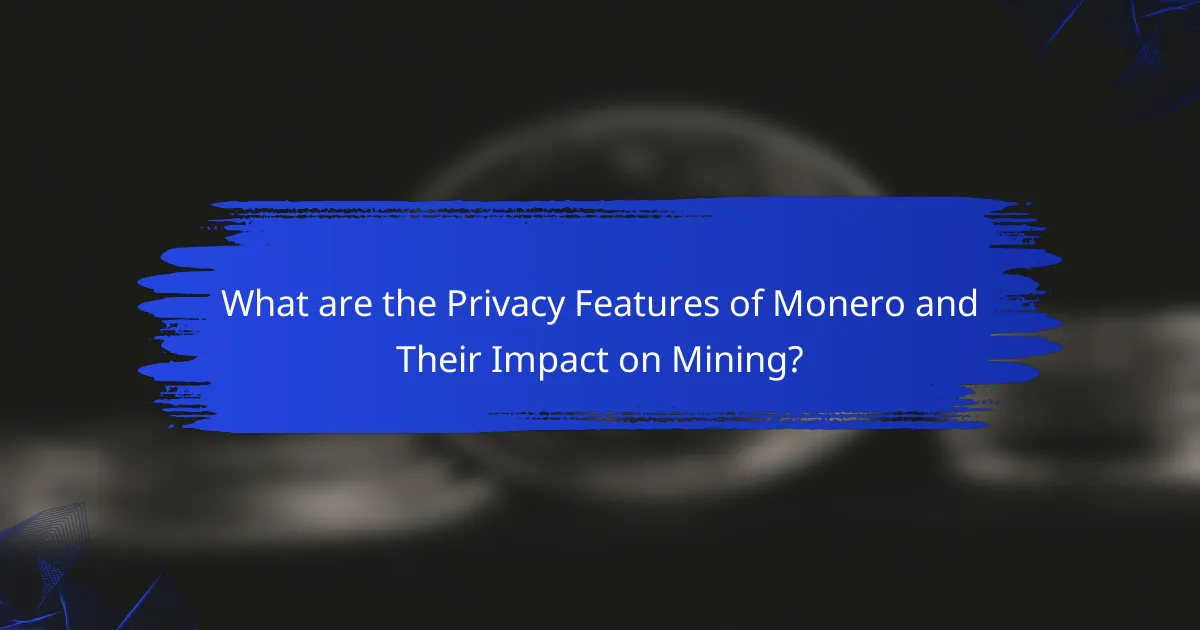Monero mining is the process of validating transactions on the Monero blockchain and generating new Monero coins, which is vital for the network’s security and integrity. This article examines the profitability of Monero mining, comparing CPU and GPU performance, while highlighting the significance of Monero’s privacy features, such as stealth addresses and ring signatures. It also discusses the impact of these privacy features on mining efficiency and energy consumption, as well as strategies to maximize mining profitability. Additionally, the article addresses market dynamics influenced by Monero’s unique characteristics and offers practical tips for optimizing mining operations.

What is Monero Mining and Why is it Important?
Monero mining is the process of validating transactions on the Monero blockchain and generating new Monero coins. This process is crucial for maintaining the security and integrity of the Monero network. Miners use computational power to solve complex mathematical problems. Successful miners are rewarded with Monero coins for their efforts. The importance of Monero mining lies in its unique privacy features. Unlike many cryptocurrencies, Monero transactions are confidential and untraceable. This privacy attracts users who value anonymity in their financial transactions. Additionally, Monero mining supports decentralization, making the network resistant to censorship and fraud. Overall, Monero mining is essential for the functionality and security of the Monero ecosystem.
How does Monero Mining differ from other cryptocurrencies?
Monero mining differs from other cryptocurrencies primarily due to its focus on privacy and anonymity. Monero employs a proof-of-work algorithm called RandomX, which is designed to be CPU-friendly. This means that mining Monero can be effectively performed using standard processors, unlike many cryptocurrencies that favor GPU mining.
Additionally, Monero utilizes advanced cryptographic techniques like ring signatures and stealth addresses. These features ensure that transaction details remain confidential and untraceable. In contrast, many other cryptocurrencies, such as Bitcoin, have transparent ledgers where transaction histories can be publicly viewed.
The emphasis on privacy makes Monero a unique entity in the cryptocurrency landscape. Its mining process is also less centralized, as more individuals can participate using accessible hardware. These characteristics collectively set Monero mining apart from the mining processes of other cryptocurrencies.
What are the unique features of Monero that affect mining?
Monero has several unique features that significantly affect its mining process. First, Monero uses the RandomX proof-of-work algorithm. This algorithm is designed to be CPU-friendly, promoting decentralization. Second, Monero employs a dynamic block size, allowing it to adjust based on network activity. This feature can influence block rewards and mining profitability. Third, Monero includes stealth addresses and ring signatures for privacy. These privacy features do not directly affect mining but impact transaction verification. Fourth, Monero’s ASIC resistance encourages a more diverse mining community. This resistance helps prevent centralization of mining power. These unique attributes collectively shape the mining landscape of Monero.
Why is Monero considered a privacy-centric cryptocurrency?
Monero is considered a privacy-centric cryptocurrency due to its advanced privacy features. It employs ring signatures, which mix multiple transactions, making it difficult to trace the sender. Additionally, Monero uses stealth addresses that create one-time addresses for each transaction, enhancing recipient privacy. The technology also includes confidential transactions, obscuring the transaction amounts. These features collectively ensure that user identities and transaction details remain hidden. Monero’s commitment to privacy is a core aspect of its design, distinguishing it from other cryptocurrencies like Bitcoin. This focus on anonymity has made Monero a preferred choice for users prioritizing privacy in their transactions.
What are the key components of Monero Mining?
The key components of Monero mining include hardware, software, and network connectivity. Hardware refers to the computing devices used for mining, such as CPUs and GPUs. Monero mining is optimized for CPUs, allowing users with standard computers to participate. Software includes mining programs that facilitate the mining process, such as XMRig or XMR-Stak. Network connectivity is essential for miners to connect to the Monero blockchain and share their mining efforts. Additionally, miners must consider power consumption and efficiency to maximize profitability. These components work together to enable successful Monero mining operations.
What hardware is required for Monero Mining?
Monero mining requires a CPU or GPU for effective operation. CPUs are commonly used due to Monero’s RandomX algorithm, which is optimized for general-purpose processors. High-performance CPUs, such as AMD Ryzen and Intel Core series, are recommended for better hash rates. GPUs can also be utilized, but they are less efficient compared to CPUs for Monero mining. Mining rigs may include multiple CPUs or GPUs to enhance performance. Adequate cooling systems are essential to prevent overheating during mining operations. Power supply units must support the hardware’s energy requirements for continuous operation.
How do CPU and GPU differ in their mining capabilities?
CPUs and GPUs differ significantly in their mining capabilities. CPUs are designed for general-purpose tasks and handle fewer threads simultaneously. They excel in tasks requiring complex calculations but are less efficient for parallel processing. In contrast, GPUs are optimized for parallel processing and can handle thousands of threads at once. This makes GPUs far more effective for mining cryptocurrencies like Monero, which relies on algorithms that benefit from parallelism.
For instance, a typical GPU can achieve hash rates exceeding 1000 H/s, while a CPU may only reach around 100 H/s. This stark difference in performance makes GPUs the preferred choice for mining operations. Furthermore, GPUs consume more power but yield higher returns due to their efficiency. Thus, in the context of Monero mining, GPUs outperform CPUs in both speed and profitability.

How do CPU and GPU Performance Compare in Monero Mining?
CPU performance in Monero mining is generally lower than GPU performance. CPUs have fewer cores and lower parallel processing capabilities compared to GPUs. GPUs excel in handling multiple tasks simultaneously, which is crucial for mining. For instance, mining Monero with a high-end GPU can yield significantly higher hash rates. Research indicates that GPUs can achieve hash rates of 800 H/s to 1,500 H/s, while CPUs typically range from 100 H/s to 300 H/s. This stark difference highlights the efficiency of GPUs in mining operations. Therefore, for optimal Monero mining, GPUs are the preferred choice due to their superior performance.
What are the advantages of using CPU for Monero Mining?
Using a CPU for Monero mining offers several advantages. CPUs allow for greater accessibility as they are commonly found in personal computers. This makes it easier for individuals to start mining without significant investment in specialized hardware.
Additionally, Monero’s proof-of-work algorithm, RandomX, is optimized for CPU performance. This means that CPUs can compete effectively with GPUs in mining Monero. Furthermore, CPU mining can be more energy-efficient for small-scale operations.
This efficiency can lead to lower operational costs, making it a viable option for hobbyist miners. Lastly, CPU mining contributes to the decentralization of the Monero network, enhancing its security and resistance to centralization.
How does CPU performance impact mining profitability?
CPU performance directly impacts mining profitability by determining the speed and efficiency of hash calculations. Higher CPU performance leads to faster processing of cryptographic algorithms. This results in more hashes computed per second, increasing the chances of successfully mining Monero. Mining profitability is also influenced by the power consumption of the CPU. Efficient CPUs reduce electricity costs, enhancing overall profit margins. According to a study, CPUs with higher hash rates can yield greater rewards over time. Therefore, optimizing CPU performance is crucial for maximizing mining profitability.
What are the limitations of CPU mining for Monero?
CPU mining for Monero has several limitations. The primary limitation is lower hash rates compared to GPU mining. CPUs generally have less processing power for cryptographic calculations. This results in longer times to solve blocks and earn rewards. Additionally, CPU mining is less energy efficient. The electricity costs can outweigh potential profits.
Another limitation is increased competition from specialized hardware. ASIC miners dominate the market, making it harder for CPUs to compete. Furthermore, CPU mining can lead to higher wear and tear on hardware. This reduces the lifespan of the CPU due to continuous high load.
Lastly, CPU mining is often less profitable in the long term. Market dynamics favor those using more efficient mining methods. These factors collectively diminish the viability of CPU mining for Monero.
What benefits does GPU mining offer for Monero?
GPU mining offers several benefits for Monero. It significantly increases hashing power compared to CPU mining. This enhanced performance leads to faster block generation and higher chances of earning rewards. GPUs are also more energy-efficient, providing better performance per watt. This efficiency translates into lower operational costs, making mining more profitable. Additionally, GPU mining allows for better scalability. Miners can easily upgrade their hardware to maintain competitiveness. The parallel processing capability of GPUs enables them to handle multiple tasks simultaneously, optimizing mining efficiency. Overall, GPU mining enhances profitability and efficiency in Monero mining operations.
How does GPU performance enhance mining efficiency?
GPU performance enhances mining efficiency by providing higher processing power compared to CPUs. This increased power allows for faster computations of complex algorithms used in mining. GPUs can execute multiple threads simultaneously, which is essential for handling the parallel nature of mining tasks. For example, a high-end GPU can achieve hash rates significantly higher than a CPU, often exceeding 1000 H/s compared to a CPU’s 100 H/s. This efficiency translates into more successful mining attempts and increased rewards. Additionally, GPUs are optimized for the mathematical operations required in mining, further enhancing their performance. Studies show that mining with GPUs can lead to a higher return on investment due to their superior efficiency and speed.
What are the costs associated with GPU mining setups?
The costs associated with GPU mining setups include hardware, electricity, and cooling expenses. Hardware costs primarily involve purchasing GPUs, which can range from $300 to over $2,000 each. A typical mining rig may require multiple GPUs, increasing the total hardware investment significantly. Electricity costs depend on local rates and the power consumption of the mining rig. For example, a rig consuming 1,000 watts may incur monthly electricity costs of $100 or more, depending on usage. Cooling solutions, such as fans or air conditioning, also add to operational costs. These cooling systems can cost anywhere from $50 to several hundred dollars. Additionally, there may be costs for mining software and potential maintenance or repair expenses. Overall, initial setup costs can range from a few hundred to several thousand dollars, depending on the scale of the operation.

What are the Privacy Features of Monero and Their Impact on Mining?
Monero’s privacy features include stealth addresses, ring signatures, and confidential transactions. Stealth addresses ensure that each transaction generates a unique address, obscuring the recipient’s identity. Ring signatures mix a user’s transaction with others, making it difficult to trace the source. Confidential transactions hide the transaction amounts, adding another layer of privacy.
These features impact mining by increasing computational requirements. Miners must process complex algorithms to maintain privacy, which can lead to higher energy consumption. The privacy-centric design may also attract a specific user base, potentially influencing demand and profitability. Monero’s focus on privacy differentiates it from other cryptocurrencies, affecting its market dynamics.
How does Monero ensure transaction privacy?
Monero ensures transaction privacy through several advanced cryptographic techniques. It utilizes ring signatures to obscure the sender’s identity. This method mixes a user’s transaction with others, making it difficult to trace. Monero also employs stealth addresses to protect the recipient’s identity. Each transaction generates a unique, one-time address for the recipient. Additionally, Monero uses confidential transactions to hide the transaction amounts. This means that only the participants can see the value being transferred. These features collectively enhance privacy and security for users. Monero’s commitment to privacy is a fundamental aspect of its design and appeal.
What technologies are used to enhance privacy in Monero?
Monero enhances privacy through several key technologies. These include ring signatures, stealth addresses, and RingCT (Ring Confidential Transactions).
Ring signatures obscure the identity of the sender by mixing their transaction with others. This makes it difficult to determine which participant in the group actually initiated the transaction.
Stealth addresses generate a unique address for each transaction on behalf of the recipient. This ensures that transactions cannot be linked to a single address, enhancing recipient privacy.
RingCT allows transaction amounts to be hidden, ensuring that the values sent in transactions remain confidential. This combination of technologies makes Monero one of the most private cryptocurrencies available.
How do privacy features affect mining profitability?
Privacy features can reduce mining profitability by increasing computational complexity. These features, such as stealth addresses and ring signatures, require more processing power. Miners need to validate transactions while maintaining user anonymity. This added complexity can lead to longer processing times and higher energy consumption. Consequently, profitability may decline due to increased operational costs. A study by the University of Cambridge found that the additional computational requirements can cut profit margins by up to 20%. Therefore, while privacy enhances user security, it can negatively impact mining profitability.
Why is market value an important consideration for Monero miners?
Market value is crucial for Monero miners because it directly impacts their profitability. Higher market value means greater potential returns for mined Monero. Miners assess market value to determine the optimal time to sell their coins. This assessment influences mining strategies and investment in hardware. For example, if market value is low, miners may choose to hold their coins instead of selling. Conversely, a high market value encourages more mining activity. Additionally, fluctuations in market value can affect mining difficulty and rewards. Understanding market value helps miners make informed financial decisions.
How does the market value of Monero fluctuate over time?
The market value of Monero fluctuates due to various factors. These include market demand, regulatory news, and technological developments. Historical data shows price volatility, often influenced by broader cryptocurrency market trends. For instance, Monero’s price reached an all-time high of approximately $500 in January 2018. Following this peak, it experienced significant declines, reflecting market corrections. In 2021, Monero saw renewed interest, with prices rising again due to increased privacy concerns among users. Additionally, changes in mining difficulty and network upgrades can impact its market value. Overall, Monero’s price is subject to rapid changes based on both internal and external factors.
What external factors influence Monero’s market value?
External factors that influence Monero’s market value include regulatory developments, market demand, and technological advancements. Regulatory changes can significantly impact investor confidence and trading activity. For instance, stricter regulations on cryptocurrencies can decrease demand for Monero. Market demand is driven by user adoption and interest in privacy features. Increased interest in privacy coins can lead to higher prices. Technological advancements, such as updates to the Monero protocol, can enhance its security and usability. These improvements can attract more users and investors, thereby influencing its market value. Economic conditions, such as inflation rates and global financial stability, also play a role in cryptocurrency valuations, including Monero.

What are the Best Practices for Maximizing Monero Mining Profitability?
To maximize Monero mining profitability, use efficient hardware and optimize settings. High-performance CPUs or GPUs significantly improve hash rates. Adjust power settings to reduce electricity costs while maintaining performance. Joining a mining pool can increase chances of earning consistent rewards. Regularly update mining software for the latest optimizations. Monitor network difficulty and adjust strategies accordingly. Lowering latency by selecting geographically closer nodes can enhance performance. Finally, stay informed about market trends to time your sales effectively.
What strategies can miners use to improve their returns?
Miners can improve their returns by optimizing hardware and software configurations. Upgrading to more efficient GPUs can significantly increase hash rates. Utilizing mining pool strategies allows for more consistent earnings compared to solo mining. Implementing energy-efficient practices reduces operational costs, enhancing profit margins. Regularly updating mining software ensures access to the latest optimizations and features. Monitoring market trends helps in selecting the most profitable coins to mine. Diversifying mining activities across different cryptocurrencies can mitigate risks and stabilize returns.
How can miners optimize their hardware for better performance?
Miners can optimize their hardware for better performance by adjusting settings and configurations. They should overclock their CPUs or GPUs to enhance processing speed. This increases hash rates, leading to more efficient mining. Additionally, miners can improve cooling solutions to prevent overheating. Efficient cooling maintains hardware performance and longevity. Updating drivers and mining software can also yield performance gains. Miners should regularly monitor system performance to identify bottlenecks. Utilizing mining pools can enhance overall efficiency by combining resources. These strategies collectively contribute to improved mining outcomes.
What tools and resources are available for Monero miners?
Monero miners have access to several tools and resources. Mining software such as XMRig and XMR-Stak is popular among miners. These programs are optimized for CPU and GPU mining. Miners can also use mining pools like MineXMR and SupportXMR for collective mining efforts. Hardware resources include CPUs from Intel and AMD, as well as GPUs from NVIDIA and AMD. Additionally, miners can utilize online calculators to estimate profitability based on current market conditions. Community forums and resources like Reddit and the Monero official website provide valuable information and support.
Monero mining is the process of validating transactions on the Monero blockchain and generating new Monero coins, emphasizing privacy and decentralization. This article explores the profitability of Monero mining by comparing CPU and GPU performance, detailing the unique privacy features that enhance user anonymity, and discussing how market value fluctuations impact mining returns. Key components such as hardware requirements, mining efficiency, and best practices for maximizing profitability are also examined. The analysis aims to provide miners with insights into optimizing their operations while navigating the complexities of the Monero ecosystem.